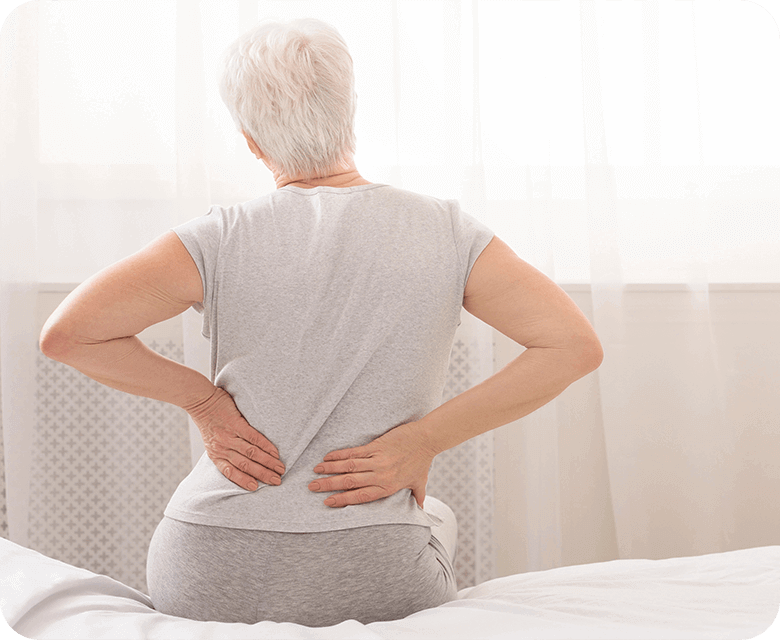Panadol Regular
Panadol Rapid
Panadol Extra
Panadol Osteo
Panadol Childrens - Liquid
Children’s Panadol Colourfree Liquid (1 Month – 1 Year)
Children’s Panadol Elixir (5 Years – 12 Years)
Panadol Childrens – Suspension
Children’s Panadol Colourfree Suspension (1 Year- 5 Years)
Children’s Panadol Colourfree Suspension (5 Years – 12 Years)
Panadol Childrens – Suppositories
Children’s Panadol Suppositories (6 Months – 5 Years)
Children’s Panadol Suppositories (5 Years – 12 Years)
Panadol Childrens – Chewable



Back pain is very common and most people will have back pain at some point in their life. Fortunately, there are a few treatments to help make you feel better.
What is back pain?
Back pains are among the top reasons people go see their doctor and miss work. Back pain can be common and the pain can range from mild to severe.

The top symptoms of back pain
The main symptoms of back pain include:
- A dull pain in the lower or upper back or around the shoulders
- A stabbing or sharp pain that moves down the leg
- Difficulty standing up straight or maintaining a straight posture
- Difficulty in moving as you normally would, e.g. bending over
The most common symptoms of back pain include a sharp or dull ache. Your back may hurt while you’re standing up or when you’re sitting or lying down. It could also come on suddenly and disappear again. For some people, the pain will only appear when they move about in a certain way, for example, when lifting heavy boxes.
What are the signs and symptoms of back pain?
When you feel pain in the back it can be uncomfortable and restrict you in your daily activities. The pain may often last not longer than a few hours or days, but sometimes it can be severe and turn chronic. Either way, back pain is usually a sign that something is wrong.

Watch out for these seven signs of back pain
1. Dull pain: Dull or throbbing pain may start in the lower back and can be accompanied by muscle spasms. This kind of pain could extend into your pelvis and hips.
2. Traveling pain: You may notice sharp or stinging pain that moves down your legs and into your feet.
3. Tingling or numbing pain: Sometimes aching in the back may feel like a tingle or a numbness that extends into the legs.
4. Shooting or stabbing pain: This type of back pain may feel particularly uncomfortable but usually comes on in short bursts.
5. Muscle spasms: You may also notice a tightness in your hip and pelvis muscles.
6. Pain after sitting: Because sitting puts pressure on the spinal discs, it can cause back problems when you sit for a long time. Usually this should resolve when you get up and move about.
7. Pain in the morning: Some people will notice a painful back when they step out of bed. This is usually due to stiffness and should go away once you move around for a bit. Your mattress, sleeping position, and pillows could also be causing your back pains.
It’s important to see a doctor right away if you notice any of the following:
- Pain that lasts longer than a few days
- Persistent aches that do not improve after 48 hours
- Bowel or bladder weakness
- A fever
What are some of the common reasons for back pain?
Back pain could be due to lots of different reasons and sometimes it may be difficult to know why you’re having problems. What’s causing your back pain may also determine whether the aching is acute, persistent, or chronic.
Acute back pain
Back aches that come on suddenly and last for a few days or weeks are described as acute back pain. They may be caused by a strain or an injury and should heal by themselves.
Persistent back pain
When your back pain lasts longer than six to 12 weeks, it could be due to a muscle or joint strain. This could affect your day-to-day activities. It’s recommended you see a doctor if the pain is persistent.
Chronic back pain
Aching and strains that last more than three months are referred to as chronic. Long-lasting pain of the back should be looked at by a medical professional and could require long-term management such as special movement exercises in addition to pain reliever.
What back treatments are available?
The treatment depends on the duration and severity of the pain. Back pain can range from mild to severe. It can last a few hours or months.

Self-care for back aches.
It’s important to contact your doctor if you are experiencing pain. If your back pain is caused by a mild strain or sprain, there are a few self-care options to help you diminish the aching.
- Rest and avoid strenuous activities
When you hurt your back, it’s important that you take a break and avoid all strenuous activity until you feel better. Otherwise, you could hinder your back from healing quickly. If you tend to sit or stand for long periods of time and it’s making your pain worse, you should take a break. Modify your daily activities according to your level of pain. - Pain medication
Pain relievers such as paracetamol or ibuprofen are available to purchase over-the-counter and can help temporarily manage your symptoms. - Apply heat or ice
A hot bath, heat wraps or pads help to relax the muscles and improve blood flow to them. The increased blood flow ensures that more oxygen and nutrients are carried to the muscle and this speeds up the healing process. When the back pain is due to inflammation, apply an ice pack instead to bring down any swelling. Heat and cold packs can be used interchangeably and alongside pain medication.
Managing persistent back pain
If you are experiencing back pain, be sure to discuss it with your doctor. They can diagnose your condition and recommend treatment. There are a number of common management methods.
- Exercises for back pain
Because your muscles support the weight of your body, it’s important to keep them strong. If back pain lasts longer than a few days, consult your doctor. It can be good idea to practice a few prescribed stretching exercises. After an injury, you’ll want to start gently and slowly build up to avoid stretches or aerobic exercises that might trigger flare-ups or cause more damage to your back. - Massage
Back pain that’s due to muscle spasms can be relieved via massage therapy. A massage can increase blood flow to the affected areas and speed up recovery.









